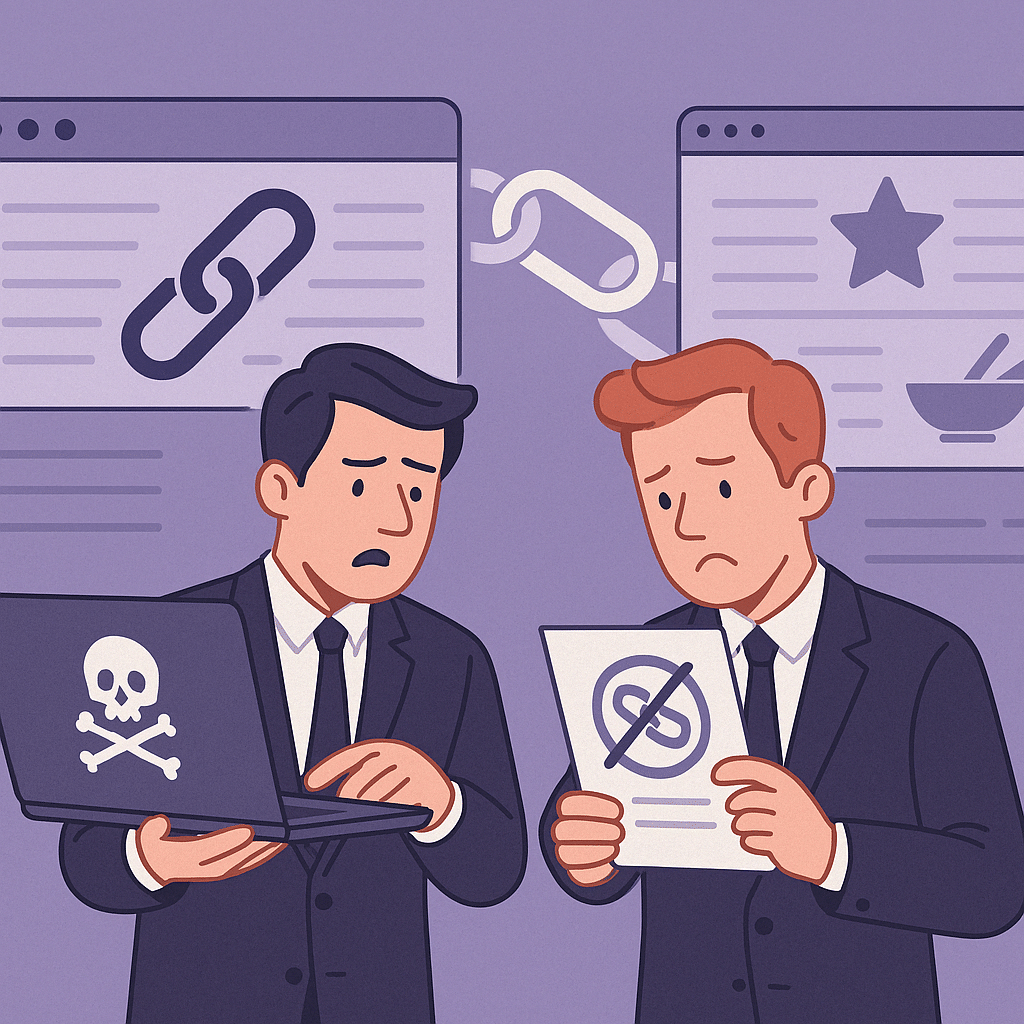Guest posts, outreach efforts—you’re checking all the link-building campaign boxes. But… Google isn’t impressed, and your rankings show it.
What gives?
Here’s the truth: 96.55% of pages get zero traffic from Google. More often than not, the content isn’t the issue—the link-building mistakes hold your website back.
At EMGI, we’ve helped tons of SaaS businesses boost organic traffic and value with effective link building. We repeatedly see the same pattern: marketers make small mistakes with big consequences.
The good news? You can fix them with less effort than you think.
Let’s break down seven errors you’re probably making and see how you can avoid them.
Is link building still relevant to SEO in 2025?
The short answer is: yes!
Google continues to list high-quality backlinks as a key ranking factor. Ahrefs analyzed 1,000,000 search engine results pages (SERPs), concluding that better link metrics lead to higher search engine rankings.
In other words, search engine optimization (SEO) without link building is like trying to win a Formula 1 race without an engine. Technically, you might be a good driver, but you’re not going anywhere.
Backlinks are still one of the strongest signals of credibility and authority in search. While great content can rank on its own in less competitive niches, that’s rarely the case in crowded spaces like SaaS. In competitive SERPs, backlinks help Google separate reputable sources from low-quality or AI-generated content.
At EMGI, we understand this distinction. Our link-building strategies are around relevance and authority, not volume. We take a relationship-driven, personalized approach to earn high-quality backlinks that help your business stand out in saturated markets and climb the rankings for keywords that matter.
Book a call to get a comprehensive link-building strategy. Or keep reading to see why you’re not ranking how you’d like to.
7 common link-building mistakes SaaS companies make (and what to do instead)
Building backlinks can be tricky. Here are seven common link-building mistakes you should avoid.
Prioritizing quantity over quality

SaaS companies often buy low-cost backlink packages from marketplaces or generalist agencies to maximize their link-building efforts. Yes, those $99 packages sound tempting when the budget is tight. However, you usually get spammy and irrelevant links that destroy your website’s reputation.
Google’s algorithms value relevance and authority—not volume. A backlink from a niche SaaS review site? Pure gold. A link from a random food blog in exchange for a guest post? Not so much.
Take one of our Clients, Viddyoze, a UK AI SaaS company. They already had a solid SEO foundation, but needed to grow more. With 70+ high-quality backlinks, we helped Viddyoze increase its organic traffic, attracting 15k monthly visitors. Still wondering—is link building still relevant to SEO? The results speak for themselves.
Ignoring content relevance
Some SaaS companies get links from irrelevant blogs or link farms, which might boost their backlink count but not their rankings.
Google uses backlinks to understand your topical relevance. If you’re a customer management platform getting low-quality links from lifestyle blogs, it undermines your authority instead of strengthening it. Worse, it can weaken keyword relevance and send mixed topical signals.
What can you do instead?
- Build contextual backlinks within articles that rank for specific keywords and are related to your target audience and product use case.
- Pitch guest posts that speak directly to your ICP’s pain point (e.g., “data integration issues for BI tools”).
- Collaborate with industry-specific content hubs, like G2 Learn Hub, Zapier or HubSpot blogs.
Not building links to commercial pages

One of the most prominent link-building mistakes? Only linking to your blog posts.
We get it—it feels safe and less promotional. But here’s the catch: your blog doesn’t close deals—your product pages do.
You shouldn’t neglect key commercial pages, such as features and pricing. They help you rank for bottom-of-funnel search terms like “{your tool} vs {competitor}” or “{feature} software.”
Build link-building strategies that support commercial pages:
- Use guest posts, internal blog content and roundups to pass link juice and build high authority.
- Create linkable content assets like data studies and templates that link to features or use cases.
- Focus on linking to pages that align with business goals.
Our work with HR Partner, an HR SaaS company, proves this is a successful link-building approach. We built 80 dofollow links with an average DR over 65 and an average traffic of over 40k organic monthly visitors.
The two main pages we targeted? High-converting service pages, which now account for an extra 1,500 clicks a month.
Mass outreach with templates
Website owners receive countless generic emails asking: “Can I contribute a guest post?” This is a one-way ticket to the spam folder. A spammy template not only gets ignored, but it can damage your reputation in these circles.
Focus on personalized and relationship-driven outreach instead:
- Personalize each pitch: Mention the site’s content, suggest improvements, or pitch topics relevant to the target audience.
- Targeted outreach: Look for reputable sites in your industry and propose content collaborations, roundups and partnerships.
- Build relationships over time: Engage on LinkedIn or X, support the content of valuable connections, pitch value and stay in touch even after getting a link.
Over-optimizing anchor text

Using exact match anchor text frequently? A link-building mistake that gets you penalties from search engines. This approach looks unnatural, harming your website’s search engine ranking.
Try natural anchor variations and brand-safe strategies:
- Use different anchor types, such as branded terms, partial matches, naked URLs and generic anchors (“Learn more”).
- Choose keywords based on the context of the content.
- Explore anchor text strategies that mimic organic mentions from third-party reviews and industry commentary.
Brand name + keyword anchor text—like “Johnson & Johnson baby powder”—is a safe and effective way to build topical relevance without over-optimizing. It helps Google associate your brand with core search terms, boosting brand recognition and supporting long-term SEO gains.
Doing SEO without link building
Do you assume that publishing high-quality content automatically leads to top search rankings? If your domain is new or has low authority, content alone won’t cut it.
Link building influences how Google and other search engines rank web pages. Although good content is key, quality backlinks demonstrate that your pages are relevant and trustworthy.
Avoid common link-building mistakes by:
- Pairing every content asset with a distribution and link acquisition plan.
- Prioritizing links that lead to your top-converting articles and key features.
Take Financial Cents, a SaaS platform for accounting firms. We secured 50+ high-quality backlinks for them. Our approach doubled Financial Cents’ organic traffic, increasing from 14k to 28k monthly visitors. The traffic value for some of these pages is over $50k a year, all thanks to a combination of off- and on-page SEO.
Not tracking link ROI

Many SaaS companies don’t track the ROI of their backlinks, focusing on vanity metrics that do nothing but look nice.
Stop counting backlinks and start measuring their performance. Here’s how:
- Use GA4, Google Search Console and Ahrefs to monitor how backlinks contribute to search rankings and traffic.
- Tie backlinks to outcomes, i.e., higher rankings or increased traffic to key pages and demo requests.
- Work with an agency like EMGI that provides impact-focused reporting.
At EMGI, we measure the results of every link and analyze how it affects traffic, revenue and keyword rankings. That’s how we know that with our help Prospeo went from 1,000 to 17,000 monthly visitors and hit the $1.5 ARR mark.
Cheap backlinks vs. high-quality backlinks: comparison table
| Link marketplaces | EMGI | |
| Link quality | Low authority, often irrelevant | High-authority, niche-relevant |
| Outreach approach | Mass, templated emails | Personalized, relationship-based |
| Anchor strategy | Over-optimized | Natural, brand-safe |
| Link reporting | Quantity-based | Impact and ROI-focused |
| Results | Short-term gains, high risk | Long-term traffic and authority growth |
Start doing link building right 🚀
Link building isn’t just about generating as many links as possible; it’s about monitoring data to spot issues like broken links and improving your strategy for better results. Solid link building impacts ranking, traffic and revenue.
Enter: EMGI.
We help SaaS companies double their monthly traffic, boost SEO performance and surpass $1.5 in ARR. These results don’t come from quality content only—they result from a personalized and relationship-driven approach to link building. At EMGI, we don’t rely on paid link schemes or PBNs. Our focus is sustainable growth through high-quality links that align with Google’s evolving standards.
Ready to see similar results for your SaaS business? Book a call!
FAQs
Is link building still effective?
Yes, it is. High-quality backlinks are still a key ranking factor for search engines. EMGI, our link-building agency, uses backlinks to help SaaS businesses drive organic traffic and improve your website’s rankings.
What should you avoid when creating a link?
You should avoid:
- Buying links
- Getting only nofollow external links
- Prioritizing quantity over quality
- Ignoring broken links
- Getting links from spammy sources
What is an example of a bad link?
One example of a bad link is a backlink from a spammy website bought to manipulate search engine rankings. This link can harm your SEO performance and get penalties from Google.
Can you do SEO without backlinks?
You may achieve some SEO success without backlinks, but they are a key ranking factor that improves your visibility on Google.